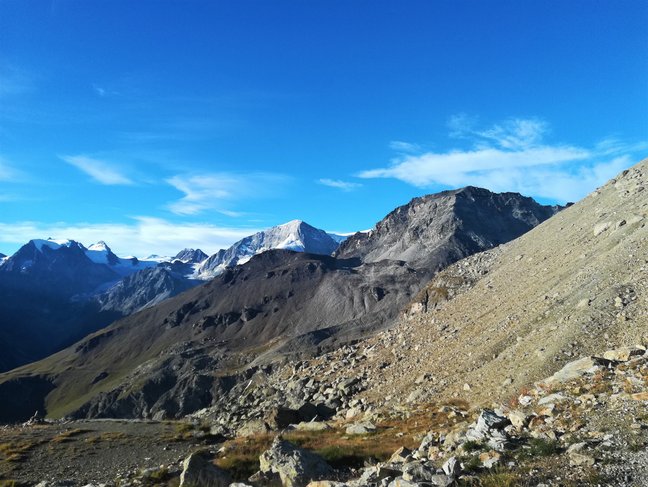Stuttgart, 01.09.2023. All land plants living today can be classified into two groups: Vascular plants, to which all ferns and flowering plants belong, and bryophytes. The latter can often only be distinguished with a great deal of specialist knowledge, mostly because of their small size. Compared to vascular plants, bryophytes are therefore still poorly researched and their fundamental importance for the global climate is hardly known outside specialist circles. An international team led by Dr. Thomas Kiebacher, botanist at the Natural History Museum in Stuttgart, has now been able to prove that bryophytes react many times faster to climatic changes than vascular plants. The study was based on data collected over 20 years as part of the Swiss Biodiversity Monitoring. Plants were systematically collected and identified throughout Switzerland. The research team's results were published in the journal Nature Scientific Reports.
Climate change is forcing many plants up the mountain
Both bryophytes and vascular plants have specific site requirements. In mountain regions in particular, the effects of climate change are noticeable in that thermophilic species are advancing to ever higher zones. Bryophytes can spread particularly quickly to higher regions. The reason for this is that they reproduce with the help of spores that can be transported very far by the wind. In addition, many bryophytes are able to thrive on bare rock and colonise new habitats early on. Bryophytes often take a pioneering role in opening up new habitats, as flowering plants are often dependent on insects and cannot spread as quickly.
Based on the newly gained data, it is becoming increasingly clear that climate change can have very different effects on certain plant groups. The scientific role of bryophytes in particular could change significantly in the upcoming years. Due to their high reaction speed, they are able to predict changes in the environment more quickly. However, bryophytes themselves are often the most threatened by climatic changes.
Reliable models need a solid data basis
Biodiversity Monitoring Switzerland is one of the programs for recording regional biodiversity. Here, almost 1500 localities were examined at five-year intervals for the presence of various groups of organisms. This data then served as the basis for computer models, which Dr Thomas Kiebacher and his team used to map and evaluate large-scale changes in plant communities.
For the editors
Original publikation:
Kiebacher, L., Meier, M., Kipfer, T. und Roth, T. (2023). Thermophilisation of communities differs between land plant lineages, land use types and elevation. Scientific Reports 13, 11395 (2023).
DOI: https://doi.org/10.1038/s41598-023-38195-6
Publication Date:14.07.2023
Biodiversity Monitoring Switzerland
Biodiversity Monitoring Switzerland (BDM) is a programme of the Swiss Federal Office for the Environment with the aim of surveying the biodiversity of selected plant and animal groups and thus highlighting their long-term development. BDM thus makes an important contribution to nature conservation policy and other policy areas. As part of the programme, biologists work together with trained citizen scientists to sample all regions of Switzerland using a systematic sampling grid.
www.biodiversitymonitoring.ch
A similar project, the floristic mapping of Baden-Württemberg, is coordinated by the Stuttgart Natural History Museum.
https://www.flora.naturkundemuseum-bw.de/start_english.htm
State Museum of Natural History Stuttgart:
The State Museum of Natural History Stuttgart is a future-oriented institute devoted to research and outreach. Its research collections, the archives of diversity, contain over 12 million objects. The museum’s research focuses on the evolution of life and analyses the biodiversity of different ecosystems and communicates research findings to the general public.
URL: www.naturkundemuseum-bw.de
Contact:
Dr. Thomas Kiebacher
Department of botany
State Museum of Natural History Stuttgart, Germany
Tel. +49 (0) 711 / 8936-141
E-mail: thomas.kiebacher(at)smns-bw.de
Press contact:
Meike Rech
State Museum of Natural History Stuttgart, Germany
Phone +49 (0) 711 / 8936-107
E-mail: meike.rech(at)smns-bw.de
Image material:
Image 1: Image1_High-Alpine Mountain Landscape (Switzerland)_Thomas_Kiebacher
Description: High alpine mountain landscape (Switzerland): The effects of global warming are most evident in the mountains.
Copyright notice: Thomas Kiebacher
Image 2: Image2_Polytrichum_Sphagnum_Thomas_Kiebacher
Description: Peat moss and maidenhair moss (Sphagnum and Polytrichum) are characteristic species of our bogs.)
Copyright notice: Thomas Kiebacher
Image 3: Image3_Tamarisken-Thujamoos_Thomas_Kiebacher
Description: The tamarisk thuja moss (Thuidium tamariscinum) is a common coloniser of forest soils.
Copyright notice: Thomas Kiebacher
Please note that use is only permitted with copyright notice. Thank you very much.
